
Table linens are more than just fabric. They help create a polished, inviting dining experience, especially in hospitality settings where presentation matters. Whether it's a casual brunch or a formal hotel banquet, clean and crisp tablecloths elevate the ambiance. But over time, food spills, frequent washes, and improper care can take their toll.
In this expert guide, you'll learn exactly how to wash tablecloths like a pro—covering everything from fabric-specific washing methods and stain removal to wrinkle prevention, drying techniques, and proper storage.
You'll Learn
- Know Your Fabric – Linen, Cotton, Polyester & More
- Stain-Free Strategy – Remove Wine, Grease, Wax & More
- Iron Like a Pro | Wrinkle-Free Tablecloths Every Time
- When to Machine Wash vs. Dry Clean?
- Proper Storage – Fresh, Flat, & Folded Tablecloths
- FAQs: How to Clean Tablecloths
- Final Tips - How to Wash Tablecloths
Know Your Fabric – Linen, Cotton, Polyester & More
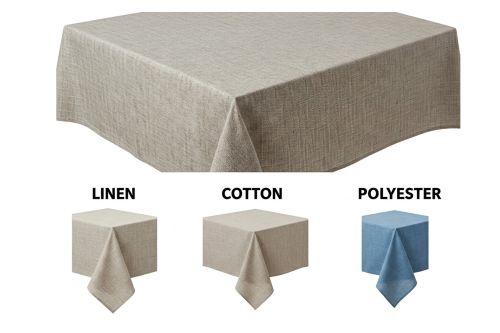
When it comes to washing tablecloths, knowing the fabric type is essential to ensure the right treatment. Not all tablecloths are created equal. Different fabrics require different washing methods, and understanding these differences will help you avoid damaging your linens. Here’s how to handle each type like a pro.
How to Wash Tablecloths Safely
Linen, cotton, and polyester are the most common fabrics used for table covers, and each has specific care requirements. Here’s how to wash these fabrics to ensure they stay in great condition.
| Fabric Type | Washing Instructions |
|---|---|
| Linen Tablecloths | Wash in cold to lukewarm water using a mild detergent. Avoid high heat to prevent shrinkage. Air-dry for best results, or tumble dry on low. |
| Cotton Tablecloths | Wash in warm water. Pre-treat stains with baking soda paste or commercial stain remover. Tumble dry, but remove while slightly damp to iron easily. |
| Polyester Tablecloths | Wash in cold water to retain color and fiber strength. Dry on low heat and remove promptly to prevent creasing. |
Washing Linen Tablecloths
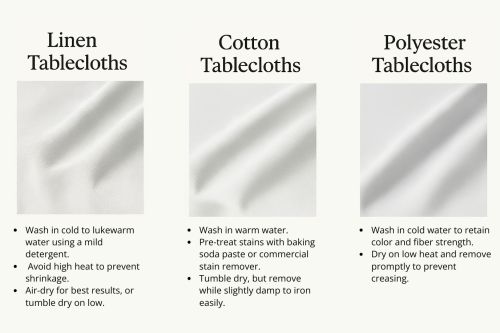
Linen is a natural fabric known for its durability and elegance, making it a popular choice for high-end table settings. However, it can be prone to shrinking if not cared for properly. To maintain the integrity and appearance of your linen table covers, always wash them in cold or lukewarm water, as hot water can cause the fabric to shrink. Use a gentle, mild detergent that preserves the linen’s delicate fibers without causing wear. When drying, air-drying is the best option to maintain the fabric’s shape and texture. If using a dryer is necessary, opt for a low heat setting to minimize the risk of shrinkage. This is crucial when learning how to wash tablecloths made from linen.
- Washing: Cold to lukewarm water, mild detergent
- Drying: Air-dry or tumble dry low
- Pro Tip: Avoid high heat to prevent shrinkage
Washing Cotton Tablecloths
Cotton is a popular choice for both casual and formal dining settings due to its softness and versatility. It’s easy to care for, but using the right washing techniques ensures longevity and preserves its quality. Start by washing cotton dining cloths in warm water, as cotton can generally tolerate higher temperatures without shrinking or fading. For stubborn stains, pre-treat the area before laundering—either with a commercial stain remover or a DIY paste made of baking soda and water. When it comes to drying, cotton tablecloths can safely go in the dryer. However, to prevent deep wrinkles, it’s best to remove them while still slightly damp and iron them immediately for a crisp, smooth finish.
- Washing: Warm water; pre-treat stains
- Drying: Tumble dry, remove slightly damp for easy ironing
- Pro Tip: Use a baking soda paste for natural stain removal
Washing Polyester Tablecloths
Polyester is a synthetic fabric known for its durability and natural resistance to stains, making it one of the easiest table cover materials to care for. Unlike more delicate fabrics, polyester can be safely machine-washed without much concern. For best results, always wash polyester tablecloths in cold water to protect the fibers and maintain their quality. When it comes to drying, tumble dry on a low heat setting and be sure to remove the tablecloth promptly to minimize wrinkles and avoid unnecessary creasing.
- Washing: Cold water protects color and fibers
- Drying: Low heat; remove promptly to prevent wrinkles
- Pro Tip: Durable and stain-resistant—ideal for high-traffic environments
Caring for Delicate or Decorative Tablecloths
Some tablecloths are made from delicate materials or feature intricate designs that require extra care. Fabrics like lace, embroidered linens, and silk demand special attention to preserve their texture and beauty. Knowing how to wash tablecloths made from these delicate fabrics is essential.
- Lace tablecloths should be hand-washed in cool water using a gentle detergent. Avoid wringing; instead, press out excess water gently with a towel and lay flat to air dry.
- Embroidered tablecloths should be placed in a laundry bag and machine-washed on the delicate cycle with mild detergent, avoiding bleach, which can damage the threadwork.
- Silk tablecloths require hand-washing only, using cold water and a silk-safe detergent. For drying, lay silk tablecloths flat away from direct sunlight to prevent fading. These table linen care tips ensure that your most fragile or vintage dining cloths stay in pristine condition.
Stain-Free Strategy – Remove Wine, Grease, Wax & More
Stains are inevitable when using tablecloths, especially in high-traffic environments like hotels and restaurants. Whether it’s red wine, tomato sauce, grease, or candle wax, knowing how to wash tablecloths properly starts with effective stain removal. The faster you treat stains, the better your chances of saving the fabric and maintaining that crisp, professional appearance.
Key Tips:
- Blot stains — don’t rub.
- Test stain removers on an inconspicuous area first.
- Use targeted treatments for different stains:
| Stain Type | Treatment |
|---|---|
| Red Wine | Blot with club soda or white wine, apply baking soda paste |
| Candle Wax | Harden with ice, scrape gently, then treat with cleaner |
| Tomato Sauce | Pre-treat with dish soap + vinegar, then warm wash |
| Ink | Dab with alcohol, rinse, then launder |
| Grease | Use pre-treatment spray or dish soap, and wash as directed |
Before you toss your table linens into the wash, it’s essential to follow a stain removal process. Begin by blotting the spill gently with a clean cloth—never rub, as this can embed the stain deeper into the fibers. Next, apply a stain remover suited for table coverings, especially those designed for table cover stain removal. For tough stains like grease or red wine, a pre-treatment spray can significantly improve your results. Always remember to test any stain remover on a hidden area to prevent potential discoloration or damage, especially important when working with delicate fabrics like lace, silk, or embroidered dining cloths.
Different stains call for tailored solutions. For red wine stains, blot the area with club soda or white wine immediately, and for set-in stains, a paste of baking soda and water can lift pigment. To remove candle wax, harden it using ice cubes, then gently scrape it off with a dull knife. Any residue can be treated with a fabric-friendly cleaner. Tomato sauce stains respond well to a pre-treatment with dish soap and vinegar, followed by washing in warm water. As for ink stains, dab the area with rubbing alcohol, rinse in cold water, and proceed with normal laundering.
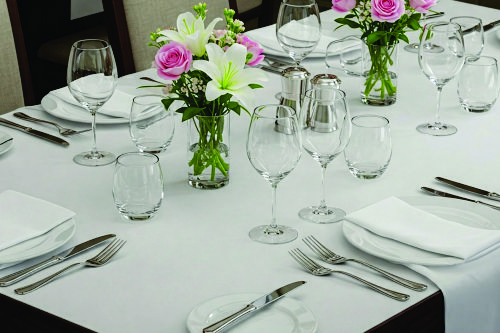
While many prefer DIY stain removal methods, commercial-grade stain removers are commonly used in hotel laundry services and professional table cover cleaning. These products are specially formulated for heavy-duty cleaning, ensuring even white tablecloths return to a bright, stain-free finish. For additional expert guidance, Consumer Reports provides evidence-backed table linen cleaning tips that can help extend the lifespan of your linens, especially in home care environments.
For home use, always choose fabric-safe options based on your specific tablecloth material, whether it’s cotton, linen, or polyester. Understanding the right approach is key to maintaining the clean, crisp look that defines hotel-quality linens.
Iron Like a Pro | Wrinkle-Free Tablecloths Every Time
One of the most common complaints with table covering is wrinkles. Whether you’re hosting a dinner party or maintaining hotel linens, ironing is an essential part of keeping tablecloths looking their best.
Ironing Large Tablecloths with Ease
Ironing a large table cover can be daunting, but with the right techniques, it’s easier than you think.
- Start with a clean, hot iron: Make sure your iron is free of any residue from previous uses.
- Use steam: Steam will help eliminate wrinkles without scorching the fabric. Make sure your iron has a steam setting.
- Iron in sections: Divide the linen tableware into manageable sections, and work your way from one end to the other. Lay the cloth flat to avoid wrinkles during the ironing process.
Iron Tablecloths Damp or Dry?
Ironing slightly damp table linens is often the most effective way to remove wrinkles with ease. The residual moisture softens fabric fibers, making creases less stubborn. Just avoid over-wetting—the cloth should be evenly damp, not soaking—otherwise, it may develop new wrinkles as it dries.
Using Steamers & Starch for a Crisp Hotel Finish
For that polished, hotel-like finish, consider using a fabric steamer or starch.
- Fabric steamer: A steamer can be less damaging than an iron and works well on delicate fabrics.
- Starch: For a crisper finish, lightly starch your table covering before ironing.
When to Machine Wash vs. Dry Clean?
Washing tablecloths isn’t always a one-size-fits-all task. Depending on the material, embellishments, and even the type of stains involved, the decision to machine wash or dry clean your linens can make the difference between a crisp, long-lasting piece and a ruined one.
How to wash tablecloths properly depends on interpreting the laundry care symbols correctly. Some fabrics require dry cleaning, especially vintage or beaded tablecloths. For delicate linens like lace and silk, hand-washing is often the safest option. If you're managing linens in a professional or healthcare setting, refer to the CDC guidelines for laundering linens to ensure hygiene standards and reduce cross-contamination risks.
Laundry Symbols and Care Labels
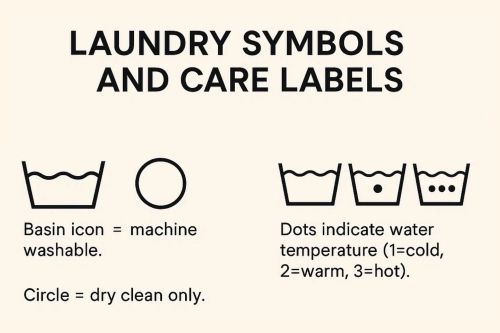
The first step to properly wash tablecloths is decoding the laundry care symbols. These tiny graphics give crucial guidance on washing temperature, cycle setting, and whether your item can go into a tumble dryer. If you see a circle, that typically indicates dry cleaning is recommended.
A basin symbol usually refers to machine washing, with added dots or lines that specify temperature (one dot for cold, two for warm, three for hot) and whether to use a gentle cycle.
Look for Symbols:
● Basin icon = machine washable. ● Circle = dry clean only. ● Dots indicate water temperature (1=cold, 2=warm, 3=hot).When to Dry Clean:
● Beaded, vintage, heavily embroidered, or silk tablecloths. ● If uncertain, test a small area or consult a professional.Misreading or ignoring these labels could result in fabric shrinkage, color bleeding, or deterioration, especially if you're dealing with vinyl table coverings or high-end damask or silk linens. When in doubt, consult the label or test a small inconspicuous area using white vinegar or a mild laundry detergent before going all in.
When Dry Cleaning is a Must (e.g., Vintage or Beaded Linens)
Some tablecloths are simply not meant for the washing machine. Vintage linens, beaded table covers, and those made from delicate materials like lace, silk, or heavily embroidered fabrics can lose their texture, color, or structure when exposed to water and agitation. These types are best entrusted to a professional dry cleaner, who uses solvent-based cleaning methods that won’t stress fragile fibers.
In hotels and banquet halls, professional linen services are often used to ensure such specialty items are handled with care. These services are well-versed in the nuances of table covers, cleaning tips for rare, valuable, or ornate pieces. If your linen holds sentimental value or was a costly investment, dry cleaning is likely the best way to preserve its elegance.
Can Tablecloths Go in the Dryer?
Another common question is whether you can safely put tablecloths in the dryer. The answer depends on the fabric type and condition. For everyday cotton tablecloths and fabric napkins, you can usually use a tumble dryer, but always choose the lowest heat setting to prevent shrinkage or warping. White linens, in particular, may yellow or become brittle if dried on high heat.
- Use low heat only for cotton and polyester.
- Never dry vinyl or laminated tablecloths.
- Air dry delicate or high-end fabrics to prevent warping.
Professional-grade dryers in hospitality settings offer controlled heat and moisture, minimizing fabric stress. At home, opt for air drying or low tumble settings to mimic these effects.
Commercial hospitality operations, such as hotels, use industrial dryers that allow precise temperature and moisture control. These machines are specially designed to protect fabrics while drying them thoroughly, often better than a clothesline on a humid day. However, at home, if you don't have access to commercial-grade equipment, consider air drying your linens on a clothesline or drying rack after washing them on a gentle cycle. Avoid placing vinyl or laminated table fabrics in the dryer altogether, as heat can cause them to warp or melt.
If you're tackling food stains—like wine, grease, or tomato sauce—pre-treat them before laundering. A solution of white vinegar and regular laundry detergent works wonders on light stains, especially on white linens. For tougher stains, avoid chlorine bleach unless the fabric specifically allows it, and opt instead for oxygen-based or color-safe bleach. Once clean, ensure that the table covering is dried thoroughly to prevent mildew during storage.
Proper Storage – Fresh, Flat, & Folded Tablecloths
Proper storage is key to maintaining your table coverings in hotel-level condition, preventing wrinkles, musty odors, and premature wear. But even the best storage methods can’t replace the importance of knowing how to wash tablecloths properly—clean linens stored incorrectly can still develop damage over time.
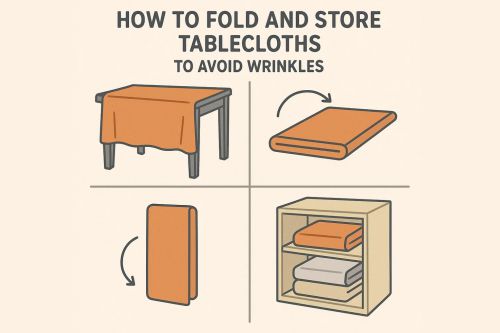
When it comes to how to fold tablecloths to prevent creases, always fold them neatly on a clean surface, smoothing out the fabric as you go to avoid setting deep lines. Avoid over-folding, which can stress the fibers and lead to premature wear. In hotel storage methods, tablecloths are often hung to preserve their smooth finish. However, if hanging space is limited, laying table linens flat on wide shelves, without stacking too many, also helps maintain their shape.
Storage Tips:
- Fold on a clean surface. Avoid sharp creases.
- Store flat or gently rolled when possible.
- Use breathable bins, fabric garment bags, or vacuum-sealed storage.
- Add sachets (lavender, cedar) or silica packs to absorb moisture and repel pests.
In hotels, hanging tablecloths in linen closets is standard for wrinkle prevention.
For storing seasonal linens, choose a cool, dry environment that prevents mildew. Storing your table covers in vacuum-sealed bags, fabric garment bags, or breathable bins protects them from moisture and pests. To enhance freshness during long storage periods, try placing sachets of lavender, silica gel packets, or cedar chips in your storage area. These natural deodorizers not only keep your table covers smelling clean but also deter insects and mildew. Whether for seasonal storage or everyday use, combining smart storage with knowing how to wash tablecloths properly will ensure your linens stay fresh, flat, and ready for elegant use.
FAQs: How to Clean Tablecloths
Can I Bleach White Tablecloths Without Damaging Them?
Yes, you can bleach safely as long as you use a color-safe bleach. Always follow the care label instructions.
What’s the Best Detergent for Table Linens in Hotels?
Hotels typically use commercial detergents designed to handle high-volume laundry. For home use, opt for a mild detergent that’s safe for your tablecloth’s fabric.
How Do I Prevent My Tablecloths from Shrinking in the Dryer?
To prevent shrinking, always dry on a low-heat setting or air-dry them.
Can I use fabric softener?
Avoid silk, lace, or embroidery — it can degrade delicate fibers.
Should I Iron My Tablecloths Before or After Storing Them?
Iron your table linens before storing them to prevent wrinkles from setting in over time.
How Do Professionals Remove Coffee or Lipstick Stains from Tablecloths?
For tough stains like coffee or lipstick, professionals often use commercial stain removers or enzymatic cleaners designed for fabric care.
Final Tips - How to Wash Tablecloths
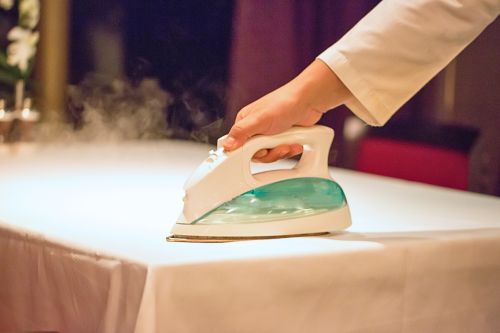
Knowing how to wash tablecloths and care for them properly is an essential skill, whether you’re hosting a special dinner at home, managing linens in a restaurant, or running a hotel. By using the right washing techniques, stain removal strategies, and storage methods, you can ensure your table covers always look pristine, crisp, and inviting.
With the right care and attention, your tablecloths can remain pristine and wrinkle-free for years to come. The key steps to remember are washing correctly, treating stains promptly, ironing properly, and storing your linens safely. By following the tips in this guide, you’ll be able to keep your table covers looking fresh and elegant, whether for a hotel setting or your own home. Looking for sustainable solutions? Here’s how to select eco-friendly table linens that are gentle on both your fabrics and the planet.
Want more hospitality tips? Follow us on Instagram and LinkedIn to join our growing community.

